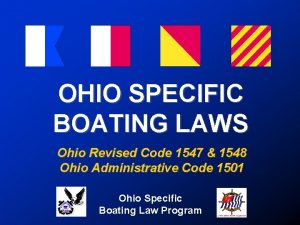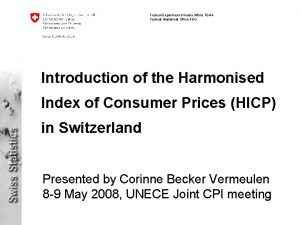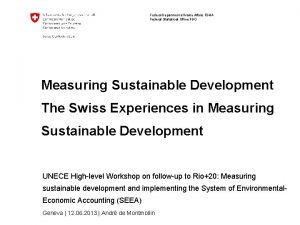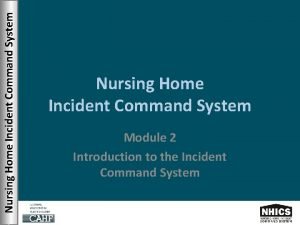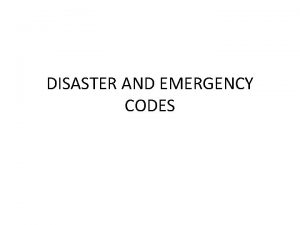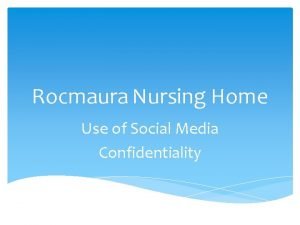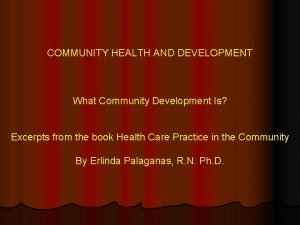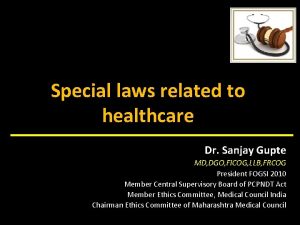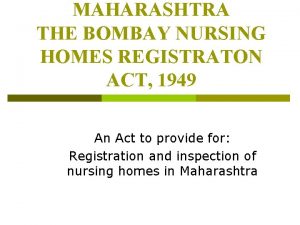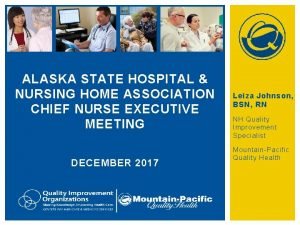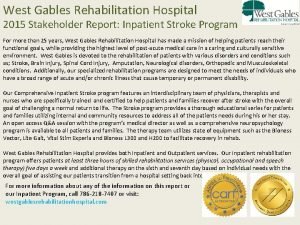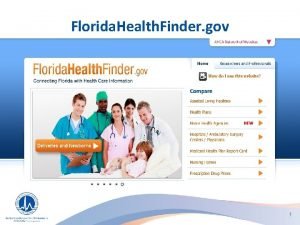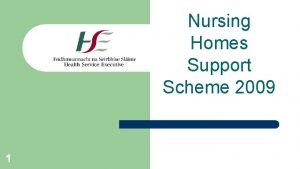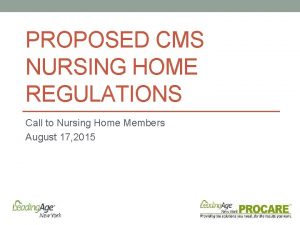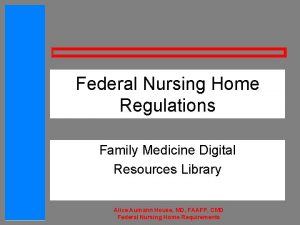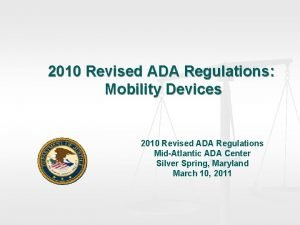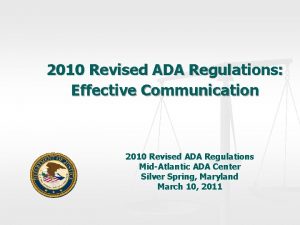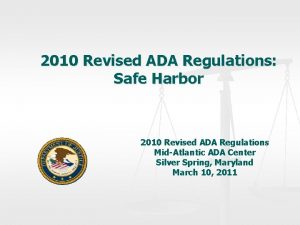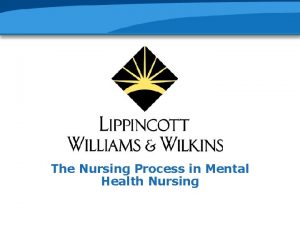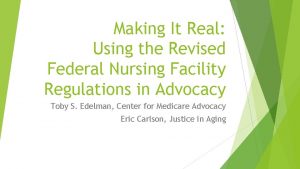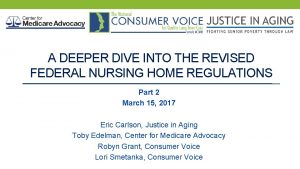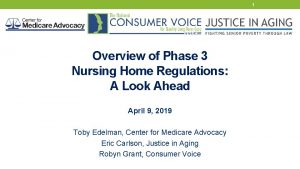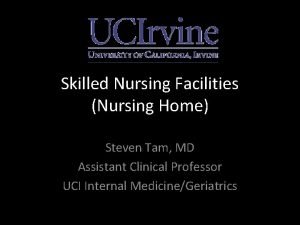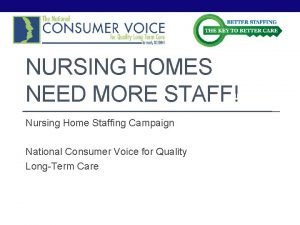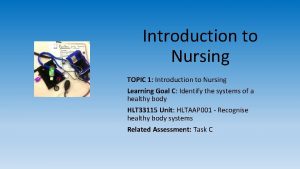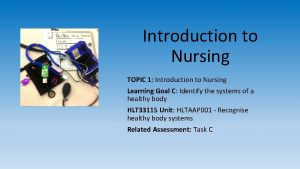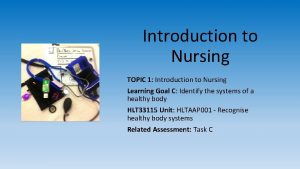INTRODUCTION TO THE REVISED FEDERAL NURSING HOME REGULATIONS
























































- Slides: 56

INTRODUCTION TO THE REVISED FEDERAL NURSING HOME REGULATIONS What’s In, What’s Not October 21, 2016 Karen Tritz, Centers for Medicare & Medicaid Services Eric Carlson, Justice in Aging Toby Edelman, Center for Medicare Advocacy Robyn Grant, Consumer Voice

Agenda • Introductions & Background Robyn Grant, Consumer Voice • CMS Overview: New LTC Rule and Survey Process Karen Tritz, Director, Division of Nursing Homes, Survey and Certification Group, Centers for Medicare & Medicaid Services • The Consumer Perspective • Preliminary Reactions Robyn Grant, Toby Edelman, Center for Medicare Advocacy • Key Areas • Admission/Transfer/Discharge/Returning to the Facility Eric Carlson, Justice in Aging • Staffing Robyn Grant • Antipsychotic/Psychotropic Medications Toby Edelman • Q&A • Closing

NEW LTC RULE AND SURVEY PROCESS Karen Tritz, Division of Nursing Homes Centers for Medicare and Medicaid Services

Changes to LTC Requirements of Participation • These requirements have not been comprehensively updated since 1991 despite significant changes in the industry. • The revisions reflect advances in theory and practice of service delivery and safety, and implement sections of the Affordable Care Act (ACA).

Themes of LTC Final Rule • Person-Centered Care • Quality • Facility Assessment, and a Competency-Based Approach • Alignment with HHS priorities • Comprehensive Review and Modernization • Implementation of Legislation

Person-Centered Care Residents and Representatives: Informed, Involved, and In Control. • Existing protections maintained • Choices • Care & Discharge Planning • Prohibit pre-dispute arbitration and requirements for post-dispute arbitration

Quality of Care and Quality of Life--overarching principles for every service. • Quality of Life and Quality of Care • Additional special care issues: restraints, pain management, bowel incontinence, dialysis services, and trauma-informed care. • Quality Assurance and Performance Improvement • Based on the pilot • Resources available - http: //www. cms. gov/Medicare/Provider. Enrollment-and-Certification/QAPI/nhqapi. html

Facility Assessment and Competency-Based Approach Facilities need to know themselves, their staff, and their residents. Not a one-size fits all approach • Accounts for, and allows for, diversity in populations and facilities • Focus on each resident achieving their highest practicable physical, mental, and psychosocial well-being •

Align with Current HHS Initiatives Advancing cross-cutting priorities • Reducing unnecessary hospital readmissions • Reducing the incidences of healthcare acquired infections • Improving behavioral healthcare • Safeguarding nursing home residents from the use of unnecessary psychotropic (antipsychotic) medications

Comprehensive Review and Modernization Bringing it into the twenty-first century • Reorganized • Updated • Consistent with current health and safety knowledge

Implementation of Legislation It’s the law • Section 6102(b) of ACA, compliance and ethics program • Section 6102(c) of ACA, quality assurance and performance improvement program (QAPI). • Section 6703(b)(3) of the ACA (Section 1150 B of the Act), requirements for reporting to law enforcement suspicion of crimes • Section 6121 of ACA, dementia and abuse training. • Section 2 of the IMPACT Act (adds 1899 B to the Act), discharge planning requirements for SNFs.

Phased in Implementation Schedule • Regulation will be implemented in 3 phases. • Phase 1: Existing requirements, those requirements relatively straightforward to implement, and those that require minor changes to survey process (November 28, 2016) • Phase 2: All Phase 1 requirements, those that providers need more time to develop, foundational elements, and a new survey process that can assess compliance. (November 28, 2017) • Phase 3: All Phase 1 and 2, and those requirements that need more time to implement (personnel hiring and training, implementation of systems approaches to quality) (November 28, 2019)

Phased Implementation Phase Primary Implementation Phase 1 • • • • • (* this section is partially implemented in Phase 2 and/or 3) Resident Rights and Facility Responsibilities* Freedom from Abuse, Neglect, and Exploitation* Admission, Transfer, and Discharge* Resident Assessment Comprehensive, Person-Centered Care Planning* Quality of Life Quality of Care* Physician Services Nursing Services* Pharmacy Services* Laboratory, radiology, and other diagnostic services Dental Services* Food and Nutrition* Specialized Rehabilitation Administration (Facility Assessment – Phase 2)* Quality Assurance and Performance Improvement* - QAA Committee Infection Control – Program* Physical Environment*

Phased Implementation (cont’d) Phase 2 • • Phase 3 • Quality Assurance and Performance Improvement* - Implementation of QAPI • Infection Control – Infection Control Preventionist * • Compliance and Ethics* • Physical Environment- call lights at resident bedside * • Training * Behavioral Health Services* Quality Assurance and Performance Improvement* - QAPI Plan Infection Control – Facility Assessment and Antibiotic Stewardship ** Physical Environment- smoking policies * * This section is partially implemented in other phases.

Implementation Timeline Implementation Date Phase 1: November 28, 2016 Phase 2: November 28, 2017 Type of Change Effective date of new Nursing Home Requirements for Participation F Tag numbering Interpretive Guidance (IG) Implement new survey process Details of Change New Regulatory Language will be uploaded to ASPEN under current F Tags New F Tag numbers IG Changes Begin surveying with the new survey process

What exactly does this mean? • For example: • 42 CFR § 483. 999 The facility must provide purple attire for all residents to wear on Sundays. • (Disclaimer: This is not a real requirement. )

Expected Impact on Phase 1 • F 156 (Closest fit in terms of regulatory intent. ) • § 483. 10(b)(1) -- The facility must inform the resident both orally and in writing in a language that the resident understands of his or her rights and all rules and regulations governing resident conduct and responsibilities during the stay in the facility… • § 483. 999 The facility must provide purple attire for all residents to wear on Sundays. • ******************* • Intent/Interpretive Guidance/Survey Process doesn’t change…

Expected Impact Phase 2 • F 980 (Formerly F 156) • § 483. XXXXX -- The facility must inform the resident both orally and in writing in a language that the resident understands of his or her rights and all rules and regulations governing resident conduct and responsibilities during the stay in the facility… • ******************* • Intent/Interpretive Guidance/Survey Process may change…

Expected Impact Phase 2 • F 999 • § 483. 999 The facility must provide purple attire for all residents to wear on Sundays. • Intent/Interpretive Guidance: what indicates compliance? (New guidance) • Survey Process changes: how will surveyors be interviewing residents and making observations? (New process)

Survey Process Changes Traditional Quality Indicator Survey Regulatory Changes Data/ Study/ Test New Survey Process

New Survey Protocol • Computer-based • Two parts • Sample Selection • Based on facility census • 70% offsite using MDS algorithm • 30% selected onsite • Investigation

New Survey Protocol • Sample Selection Process: • Day 1 = Interview and observe potential sample residents, and review record/matrix as needed • Day 1/Day 2 = Finalize sample

New Survey Protocol • Investigative Process: • Remainder of survey = investigating residents and tasks • Facility Tasks: • Required/Concern specific tasks • Resident Council Meeting • New ABN Beneficiary Notice Survey Process

What Training Will be Available • Phase 1: Recorded Webinar – highlighting Phase 1 changes • Tools - Which tags have new language added – mid-November. • Phase 2: Webinar and National Provider Calls • New Tags, Interpretive Guidance, and Survey Process

Resources for More Information • The Medicare Learning Network® call – October 27, 2017 • Mid-November – Surveyor Webinar for Phase 1 (open to all) • Watch S&C letters https: //www. cms. gov/Medicare/Provider- Enrollment-and-Certification/SUrvey. Certification. Gen. Info/Policy-and -Memos-to-States-and-Regions. html • E-mail: NHSurvey. Development@cms. hhs. gov

THE CONSUMER PERSPECTIVE

PRELIMINARY REACTIONS q. A mixed bag

IMPROVEMENTS q. Ban on pre-dispute arbitration agreements q. Person-centered care q. Resident choice and engagement q. Residents’ rights q. Grievance process q. Resident funds/property q. Involuntary moves within the facility q. Abuse, neglect, and exploitation q. Baseline care plan, behavioral health services, and enhanced training requirements

THEMES IN PREAMBLE (POSITIVE) q“Our primary concern is to protect the health and safety of residents. ” (p. 68727) q“Quality of Care and Quality of Life are two separate and overarching principles in the delivery of care to residents of LTC facilities. ” (p. 68745) q“[W]e proposed to retain all existing resident’s rights, but update the language and organization of the resident rights provisions to improve logical order and readability, to clarify aspects of the regulations that warranted it, and to update provisions to include technological advances such as electronic communications. ” (p. 68702) q“[W]e do not intend in this update to diminish resident rights or protections. Rather, we want to ensure that those rights and protections encompass advancements, such as in the area of telecommunications, . . ” (p. 68704)

THEMES IN PREAMBLE (POSITIVE) q“It is not our intent to reduce a resident’s access to information. ” (in discussion of access to medical records) (p. 68720) q“Person-centered care is a focus of these requirements” (p. 68762) q“[W]e believe that the requirements finalized in this rule will strengthen the protections for residents concerning pharmacy services and improve our oversight of these [psychotropic] drugs used in LTC facilities. ” (p. 68766); “These requirements are intended to decrease, and hopefully eliminate, inappropriate psychotropic drug use and the use of medications for reasons other than the resident’s benefit. ” (p. 78767)

CONCERNS q. Staffing q. Dementia care q. Social workers

KEY AREAS

Admission: Prohibiting Pre-Dispute Arbitration Agreements q. CMS had asked whether to ban pre-dispute arbitration agreements. q. Answer – Yes, because arbitration has negative impact on quality of care. q Note – post-dispute arbitration is still allowed. q AHCA has filed lawsuit challenging this prohibition.

No Financial Guarantees q New regulations prohibit a facility from requiring or requesting a third-party financial guarantee. q Does not address situation where agent takes on responsibility to pay resident’s money to facility, and to arrange for Medicaid eligibility. q CMS says they will “further investigate this concern. ”

More Enforcement Attention on Admission Agreements? q “The terms of an admission contract by or on behalf of an individual seeking admission to the facility must not conflict with the requirements of these regulations. ” q This is a positive step because admission agreements frequently conflict with relevant law.

The Six Justifications for Involuntary Transfer-Discharge q Same as before, but with some changes in wording. q “Safety of others” justification is now limited to endangerment “due to the clinical or behavioral status of the resident. ” q “Nonpayment” does not occur if the resident has submitted the necessary paperwork for third party reimbursement.

More Focus on Claims that Facility Cannot Meet Resident’s Needs q Specific documentation required if transfer/discharge “is necessary for the resident’s welfare and the resident’s needs cannot be met in the facility. ” q Medical record must include: q “Specific resident need(s) that cannot be met”; q “Facility attempts to meet the resident needs”; and q “Service available at the receiving facility to meet the need(s). ” q Also note: requirement at pre-admission that the facility provides “notice of special characteristics or service limitations. ”

Some New Protections q No transfer/discharge while appeal is pending, absent documented endangerment to health or safety of resident or others. q Facility must send copy of transfer/discharge notice to long-term care ombudsman program.

Returning to Facility q Facility must give notice of bed-hold policy. q Facility must also allow a return to the next available room. q Must be previous room if available.

Preventing Residents from Being “Dumped” in Hospitals q If facility determines resident “cannot return to the facility, ” then the facility must comply with transfer/discharge regulations “as they apply to discharges. ” q This is a cross-reference to section that begins with statement that “before a facility transfers or discharges a resident, ” facility must provide advance notice in manner required by regulations. q CMS states that it has made revisions “to better address concerns that [the initially-proposed language] would allow patient dumping. ”

STAFFING: LEVELS/NUMBERS NO required minimum staffing standard or increase in staffing levels

Activities and Social Services No change in language (except qualifications) Nursing, Food and Nutrition Services, Behavioral Health Services (completely new section) Change • Sufficient staff: • With appropriate competencies and skill sets • As determined by resident assessments and individual plans of care • Taking into consideration the number, acuity and diagnoses of the facility’s resident population in accordance with the facility assessment

STAFFING: FACILITY ASSESSMENT • To determine what resources are needed to competently care for residents • Must be reviewed and updated: • As necessary, but at least annually • Whenever there is any change, or plans for a change, that would require major modification of the assessment

STAFFING: FACILITY ASSESSMENT • Resident population • Number of actual residents • Facility’s resident capacity • Care required by resident population taking • • into consideration Types of diseases Conditions Physical and cognitive disabilities Overall acuity Staff competencies needed to the level of care and type of care needed for resident population Physical environment, equipment, services, and other physical plant factors necessary to care for resident population Ethnic, cultural, and religious factors • Facility resources • Buildings and/or other physical • • • structures Vehicles Equipment (medical and non-medical) Services provided All personnel and their education/training and competencies related to care Any type of arrangement/agreement with third parties for services or equipment Health information technology

STAFFING: TRAINING • The facility must develop, implement, and maintain an effective training program for: • All existing staff • All new staff • Contract employees • Volunteers

STAFFING: TRAINING • Required topics include: • Communication • Resident’s rights and facility responsibilities • Abuse, neglect, and exploitation • Dementia management and resident abuse prevention • Quality Assurance and Performance Improvement • Infection control • Compliance and ethics • Behavioral health

STAFFING: TRAINING • Nurse aide in-service training • Dementia management and resident abuse prevention

ANTIPSYCHOTIC DRUGS: CURRENT RULES • Address “unnecessary drugs” as part of quality of care rules, § 483. 25(l) • Include subsection on antipsychotic drugs, § 483. 25(l)(2): • Subsection (i) residents should not get antipsychotic drugs “unless antipsychotic drug therapy is necessary to treat a specific condition as diagnosed and documented in the clinical record” • Subsection (ii) requires gradual dose reductions, behavioral interventions “unless clinically contraindicated, in an effort to discontinue these drugs”

ANTIPSYCHOTIC DRUGS: NEW RULES • CMS moves “unnecessary drugs” from quality of care regulations, current § 483. 25(l), to pharmacy services, § 483. 45 • Creates new broader category of psychotropic drugs, which are defined to include not only antipsychotic drugs, but also anti-depressants, antianxiety, and hypnotics. § 483. 45(c)(3)(i)-(iv) • Redesignates current protections for “unnecessary drugs” (i. e. , § 483. 25(l)(1) (i)-(vi)), using identical language at § 483. 45(d)(1)-(6)) • Repeats current protections for antipsychotic drugs (§ 483. 25(l)(2)(i)-(ii)) for all psychotropic drugs (§ 483. 45(e)(1)-(2))

PSYCHOTROPIC DRUGS: NEW RULES • Creates new rules for PRN (“as needed”) psychotropic drugs and different rules for PRN antipsychotic drugs • PRN orders for psychotropic drugs are limited to 14 days (unless the attending physician or prescribing practitioner documents rationale in the medical record and indicates the duration for the PRN order), § 483. 45(e)(4). • PRN orders for antipsychotic drugs are limited to 14 days “and cannot be renewed unless the attending physician or prescribing practitioner evaluates the resident for the appropriateness of that medication”, § 483. 45(e)(5)

PSYCHOTROPIC DRUGS: NEW RULES, PREAMBLE • Accepts comments to modify definition of psychotropic drugs, eliminating opioid analgesics and expansive “any other” language for drugs having similar effects, while reserving the right to add other drugs in Interpretive Guidelines. (pp. 68770, 68769) • Declines comment to incorporate requirements from proposed rule published in 1992, 57 Fed. Reg. 4516 (Feb. 5, 2012). CMS says it did not propose these requirements again because they were “too prescriptive. ” (p. 68775) • Accepts comment to extend PRN from 48 hours in proposed rules, and describing 48 -hour proposal as “burdensome for some facilities. ” (pp. 68772 -68774)

DRUG REGIMEN REVIEW • Current rule, § 483. 60(c), requires • Monthly review of each resident’s drug regimen by licensed pharmacist (§ 483. 60(c)(1)). • Reporting of irregularities to the attending physician and director of nursing (§ 483. 60(c)(2)). • New rule, § 483. 60(c), requires • Monthly review of each resident’s drug regimen by licensed pharmacist (§ 483. 60(c)(1)) (although this section is not published in the Fed. Reg. ) (unchanged) • Drug regimen review includes a monthly review of medical record (§ 483. 60(c)(2)). • Reporting of irregularities to the medical director (as well as to the attending physician and director of nursing) (§ 483. 60(c)(4)). • New requirement that a physician document the review of pharmacist’s report; “what, if any, action has been taken to address it, ” and rationale for not making change (§ 483. 60(c)(4)(iii)). • New requirement for facility to develop and maintain policies and procedures for the monthly drug regimen review (§ 483. 60(c)(5)).

DRUG REGIMEN REVIEW, PREAMBLE • Accepts comment to require pharmacist to review medical records monthly, not every six months (as CMS proposed). (p. 68767) • Declines comment to require pharmacist’s report of irregularities to be given to resident/resident’s representative. (p. 68768) • Affirms proposed rule’s requirement that medical director be informed of irregularities identified by pharmacist. (p. 68769) • Declines comment to require independence of consultant pharmacists. (p. 68769) (as CMS proposed, CMS-4157 -P, 76 Fed. Reg. 63017, 63038 -63041 (Oct. 11, 2011), but declined to make final, 77 Fed. Reg. 22701, 22101 -22107 (Apr. 12, 2012))

Question and Answer

STAY TUNED Resources & more webinars are coming!

• Karen Tritz NHSurvey. Development@cms. hhs. gov • Eric Carlson ecarlson@justiceinaging. org www. justiceinaging. org • Toby Edelman tedelman@Medicare. Advocacy. org www. medicareadvocacy. org • Robyn Grant rgrant@theconsumervoice. org www. theconsumervoice. org
 Expired tags orc
Expired tags orc Federal department of home affairs fdha
Federal department of home affairs fdha Federal department of home affairs fdha
Federal department of home affairs fdha Federal department of home affairs fdha
Federal department of home affairs fdha Perbedaan home care dan home service
Perbedaan home care dan home service Perbedaan home care dan home visit
Perbedaan home care dan home visit New mobile home sales oak springs mobile home community
New mobile home sales oak springs mobile home community Unit 1 home sweet home
Unit 1 home sweet home Come home come home jesus is calling
Come home come home jesus is calling Oak springs mobile home park
Oak springs mobile home park America my home sweet home
America my home sweet home André fougeron
André fougeron She said that, home economics stands for the ideal home.
She said that, home economics stands for the ideal home. Home sweet home survive crash
Home sweet home survive crash Nursing home chain of command
Nursing home chain of command Nursing home chain of command
Nursing home chain of command Fire notification.mchs
Fire notification.mchs Purpose of home visiting in community health nursing
Purpose of home visiting in community health nursing Rocmaura nursing home
Rocmaura nursing home Components of home visit
Components of home visit Ce winslow goal of public health
Ce winslow goal of public health Dr sanjay gupte
Dr sanjay gupte Bombay nursing home act registration form
Bombay nursing home act registration form Redwood nursing home
Redwood nursing home Alaska state hospital and nursing home association
Alaska state hospital and nursing home association West gables nursing home
West gables nursing home Significant 7 tool
Significant 7 tool Florida health care finder
Florida health care finder Nursing home support scheme
Nursing home support scheme Kensington village nursing home
Kensington village nursing home Hát kết hợp bộ gõ cơ thể
Hát kết hợp bộ gõ cơ thể Slidetodoc
Slidetodoc Bổ thể
Bổ thể Tỉ lệ cơ thể trẻ em
Tỉ lệ cơ thể trẻ em Chó sói
Chó sói Thang điểm glasgow
Thang điểm glasgow Alleluia hat len nguoi oi
Alleluia hat len nguoi oi Các môn thể thao bắt đầu bằng từ đua
Các môn thể thao bắt đầu bằng từ đua Thế nào là hệ số cao nhất
Thế nào là hệ số cao nhất Các châu lục và đại dương trên thế giới
Các châu lục và đại dương trên thế giới Công thức tiính động năng
Công thức tiính động năng Trời xanh đây là của chúng ta thể thơ
Trời xanh đây là của chúng ta thể thơ Mật thư anh em như thể tay chân
Mật thư anh em như thể tay chân 101012 bằng
101012 bằng Phản ứng thế ankan
Phản ứng thế ankan Các châu lục và đại dương trên thế giới
Các châu lục và đại dương trên thế giới Thể thơ truyền thống
Thể thơ truyền thống Quá trình desamine hóa có thể tạo ra
Quá trình desamine hóa có thể tạo ra Một số thể thơ truyền thống
Một số thể thơ truyền thống Cái miệng bé xinh thế chỉ nói điều hay thôi
Cái miệng bé xinh thế chỉ nói điều hay thôi Vẽ hình chiếu vuông góc của vật thể sau
Vẽ hình chiếu vuông góc của vật thể sau Thế nào là sự mỏi cơ
Thế nào là sự mỏi cơ đặc điểm cơ thể của người tối cổ
đặc điểm cơ thể của người tối cổ Giọng cùng tên là
Giọng cùng tên là Vẽ hình chiếu đứng bằng cạnh của vật thể
Vẽ hình chiếu đứng bằng cạnh của vật thể Tia chieu sa te
Tia chieu sa te Thẻ vin
Thẻ vin
